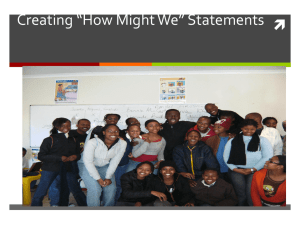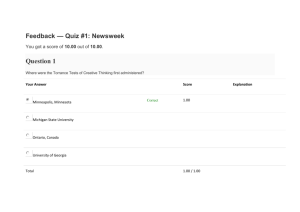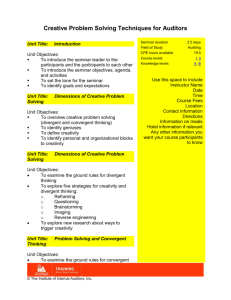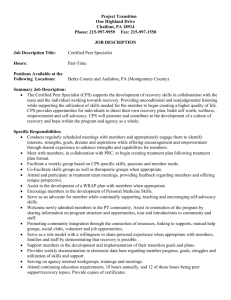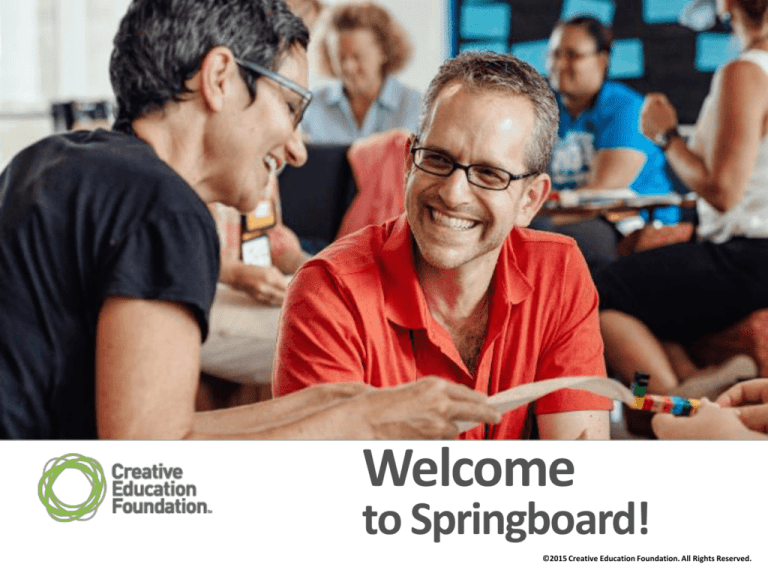
Welcome
to Springboard!
©2015 Creative Education Foundation. All Rights Reserved.
Objectives
•
•
•
•
Overcome blocks to creativity.
Identify behaviors conducive to creative thinking.
Apply core principles of creative thinking.
Utilize a variety of divergent &
convergent thinking tools.
• Apply the CPS method to
simulated or real situations.
• Practice being deliberately
creative.
What is creativity?
Some Definitions of Creativity
• “Novelty that is useful.”
First referenced in 1724 in the text, The Irish Historical
Library, and later by Stan Gryskiewicz, PhD, Center for Creative
Leadership.
• “Creativity is the production of
novel and useful ideas in any
domain.”
Teresa M. Amabile, PhD, Harvard Business School
• “Creativity is the process of
bringing something new into
being.”
Rollo May, Ph.D., existential psychologist
History of CPS
• We all solve problems
naturally
• Alex Osborn, the inventor of
brainstorming, wanted to
make the process more
deliberate
• CPS has been around for 61
years!
• Evolution of the CPS Model
Other Creativity Systems
Design
Thinking
KepnerTregoe
Improvisation
Lateral
Thinking
Six Thinking
Hats
Synectics
Systems
Thinking
TRIZ
Barriers & Bridges
• Attitudes
• Environment
• Skills
• Structures
• Behaviors
CoreConcepts
Concepts
Core
©2015 Creative Education Foundation. All Rights Reserved.
Separate
Divergent & Convergent Thinking
Area of
Discovery
Puccio, G. J., Murdock, M. C., & Mance, M. (2006)
Area of Familiarity
Dynamic Balance
Area of
Discovery
Divergent Guidelines
• Defer Judgment
• Build on Ideas
• Seek Wild Ideas
• Go for Quantity
Affirmative Judgment (Praise First)
PPCO
Pluses, Potentials, Concerns, Opportunities
•
•
•
Balanced approach to evaluating ideas
Gives ideas a fair hearing
Creates an opportunity to overcome
weaknesses and strengthen ideas
Design for New Wheelbarrow
Handle
Hopper
Wheel
Affirmative Judgment (Praise First)
Lifetime Products has reinvented the wheelbarrow! The innovative design
gives you superior stability and added maneuverability - lightening your
workload by an amazing 85%.
Convergent Guidelines
• Be deliberate
• Check your objectives
• Improve your ideas
• Be affirmative
• Consider novelty
Have a Creative Attitude
“Now here’s my plan...”
Shel Silverstein, Look Magazine, 1956
Summary of Core Concepts
•
•
•
•
•
•
The Dynamic Balance of Creativity
Divergent Thinking
Convergent Thinking
Praise First; Yes, And Thinking
Stage Challenges as Questions
Have a Creative Attitude
The Big Bad Wolf Case Study
The CPS Model
Based on the work of G.J. Puccio, M. Mance, M.C. Murdck, B. Miler, J. Vehar, R. Firestien, S. Thurber, D. Nielsen (2011)
The CPS Process
Based on the work of G.J. Puccio, M. Mance, M.C. Murdock, B. Miler, J. Vehar, R. Firestien, S. Thurber, D. Nielsen (2011)
Clarify - Identifying the Challenge
3 Steps
• Explore the vision
• Gather data
• Formulate the challenge
Explore the Vision
Generate Goal/Wish Statements
• It would be great if….
• I wish…
Tool: Word Dance
Example:
A social group wants to expand its
membership. They have expressed the
challenge as:
“How might we get more members?”
Playing WORD DANCE, they swap the verb
“get” and the object “members” with a
series of substitutes. They end up with
similar challenges, with a new twist.
HMW entice members?
HMW attract candidates?
HMW solicit contributions?
Parnes, S. (1967). Creative behavior guidebook. New York: Scribner.
Get
Members
attract
participants
induce
supporters
solicit
helpers
lure
leaders
entice
applicants
collect
contributors
retain
candidates
Explore the Vision
Select a Goal/Wish Statement
Use Tool 3 “I”’s to check for…
• Influence – Is it your responsibility?
• Interest – Do you really want to solve it?
• Imagination – Do you need creative ideas?
Gather Data
•
•
•
•
•
•
Who?
What?
When?
Where?
Why?
How?
Formulate the Challenge
Generate Well-Defined Challenges
• Invitational Language Stems
How to… (H2...)
How might... (HM…)
In what ways might… (IWWM…)
• Turn Data into Challenge Questions
• Not
Ideas - A Better Definition of the Real Challenge
How
to…?
In• What
We…?
BroadWays
– BriefMight
– Beneficial
What are all the ways to…?
Characteristics of a
Good Challenge Statement
Statement Starter
+
Owner
+
Verb
+
Object
• Begins with a statement starter
How might…
How to…
In what ways might…
• Free from criteria
• Specific focus or action
We don’t have enough money.
How to raise the money?
It’s too expensive.
How might we reduce the cost?
We need to be more innovative.
How might we build a culture of innovation?
Energizing Questions
Before:
HMW position our new Tax-Free Account as the smartest
savings vehicle of choice in a crowded marketplace?
HMW transform ourselves into the most environmentally
responsible company in the film industry in terms of our
production practices, supplier management systems &
operations.
HMW communicate in such a way that all employees
receive consistent messages so that they have the
“correct” understanding to be able to enhance their
performance and act in the best interests of their
colleagues and our firm?
After:
• HMW make saving sexy?
• HMW become the Prius of
the film industry?
• HMW make sure our
people really “get it”?
How might we truly understand what drives employees
loyalty and dedication so that we can establish an systems • HMW have employees who
and an environment in which we achieve the highest
rather die than miss work?
attendance standards in the industry?
Source: thinkx
End of Day One
Welcome Back!
Day 2
©2015 Creative Education Foundation. All Rights Reserved.
Ideate
©2015 Creative Education Foundation. All Rights Reserved.
Explore Ideas
• Think up lots of
options
• Explore new
combinations
• Build on ideas
Tool: Forced Connections
Get unstuck: Force a connection between your
challenge and something completely unrelated.
1. Ponder an unrelated image
2. Write five characteristics
3. Ask “what ideas do I get for solving this
challenge?””
Force a connection
When I look at this picture, what ideas do
I get for solving my challenge?
Force a connection
When I look at this picture, what ideas do
I get for solving my challenge?
Tool: Brainwriting
Build on others‘ ideas to generate more
ideas fast.
1. Write three ideas to fill a row
2. Toss your sheet into the pile
3. Grab another person’s sheet
and build on their ideas with
three more ideas!
Tool: SCAMPER
S
Substitute
Is there something you could put in place of something
else? Consider materials and manufacturing processes.
C
Combine
What parts could be put together? Blended?
What applications, uses, materials could be provided?
A
Adapt
How might your competitor evolve it?
What would a super-user do to make it better?
M
Modify
What can you alter? Consider all 5 senses.
Can you subtract, change or alter anything?
P
Put to Other Uses
What else can it be used for? Each part?
Who else might like it?
E
Eliminate
What part can you get rid of or omit?
What can you do without?
Rearrange
What can be rearranged or reversed?
Patterns and assumptions?
What can you connect in a different way?
R
Tool: Visual Connections
What do you see? What do you feel like? What would it be like if you were here?
What memories have you had like this? What experiences have you had like this?
What might this taste/sound/smell/feel like?
A twist on Forced Connections
Tool: Highlighting
1.
Identify Hits
Clear
Interesting
Feels Right
Intriguing
Solves the Challenge
2. Cluster the related “hits” together
3. Restate the cluster
Sorting Criteria
‘MUST’ CRITERIA
• Absolute requirement
• Deemed to be critical
for success
• Without this feature the
solution will fail
‘WANT’ CRITERIA
• Highly desirable feature
• Important, but not an
absolute requirement
• Plays a value-added role
(makes solution more
attractive)
• Novelty! Novelty!
Restating Ideas
What I see myself doing is…
Example 1
Example 2
• WISMDI reducing
production costs by
25% in the next year by
replacing our current
production line with a
new system.
• WISMDI breaking our
current communication
paradigm by developing
a cross-functional team
that includes 3 people
each from marketing,
finance, and research
and development.
Develop
©2015 Creative Education Foundation. All Rights Reserved.
Formulate Solutions
Turning Ideas Into Solutions
• Evaluate and strengthen ideas
• Plan useful, practical solutions
• Take an idea from good to great
• Consider Novelty
• Use Affirmative Judgment
Tool: Evaluation Matrix
Options
Criteria
Affirmative Judgment - PPCO
Pluses, Potentials, Concerns and Opportunities
•
•
•
•
Balanced approach to evaluating ideas
A critical thinking tool
Opportunity to give an idea a fair hearing
Create an opening to overcome the
weaknesses of an idea
Implement
©2015 Creative Education Foundation. All Rights Reserved.
Formulate a Plan
• Explore acceptance - consider
all the resources that can assist
and resist your solution
• Identify action steps
• Make a plan
Tool: Assisters & Resisters
Consider all the resources that can assist and resist
your solution:
• Who - individuals or
groups who will help or
hinder
• What - things that
might help or hinder
• When - issues of timing
that might help or
hinder
• Where - physical or
process locations that can
help or hinder
• Why - reasons that
support or block progress
• How - actions that will
help or hinder
Identify Action Steps
• What steps might you take to put your solution into
action?
• What additional resources might help you
implement your solution?
• How might you gain enthusiasm for your solution?
• Where might you start?
• What special places or locations might you use?
• What are some places or locations to avoid?
• When might be a good time to begin?
• How might you pretest your solution?
Tool: Action Plan
In the next 24 hours, I will …
FourSight Workshop
1.30 PM @ CPSI HUB
End of Day Two
End of Day Two
Welcome Back!
Day 3
©2015 Creative Education Foundation. All Rights Reserved.
The CPS Model
Based on the work of G.J. Puccio, M. Mance, M.C. Murdock, B. Miler, J. Vehar, R. Firestien, S. Thurber, D. Nielsen (2011)
Summary - Divergent Tools
• Brainstorming
• Stick-Em Up
Brainstorming
• Brainwriting
• Forced Connections &
Visual Connections
• SCAMPER
• Why What’s Stopping
You
• Word Dance
Summary - Convergent Tools
Dot Voting, 3 “I”’s, Highlighting,
Evaluation Matrix, PPCO, Action Plan
CPS Practice:
Real-World Challenge
with a Client
©2015 Creative Education Foundation. All Rights Reserved.
Topic Market
Extend Your Learning - Resources
PRACTICE, PRACTICE, PRACTICE
Springboard
Facebook Group
Creative Problem Solving
Institute
Taking It Forward
what?
so what?
now what?
Thank You
and See You Next Year!
CPSI 2016
June 15-19, Buffalo

